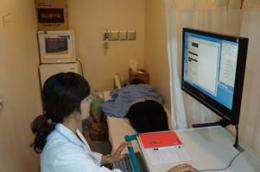Software for new cancer screening method

Women may one day have a more accurate, less expensive means of detecting breast cancer, thanks in part to software developed by two South Dakota State University computer science professors.
Microwave tomography imaging, or MTI, has the potential to produce an image capable of finding cancer, even in women with dense breast tissue, at a fraction of the cost of current techniques, said professor Sung Shin. Since 2010, Shin and assistant professor Wei Wang have been working on this project with scientists from The Electronics and Telecommunications Research Institute and Chung Nam University in Daejeon, South Korea.
The government-owned research institute, which holds the patent on the microwave tomography machine, is developing its capabilities as a cancer screening tool, Shin explained. The experimental procedure was approved for use on human subjects in Korea last summer and the first 15 patients were screened in the fall. Each patient was evaluated using MTI, magnetic resonance imaging— or MRI—and mammography.
On this portion of the international collaborative project, Shin is working with Dr. Wu-Kyung Moon of Seoul National University, a medical doctor and one of South Korea's leading cancer researchers. Shin returned from Korea in January with the imaging data.
"We have rich information now," Wang said.
The software they develop will first identify the tumor on the MTI and then compare that image to a database of more than 100,000 MRI images. Next, the program will choose the cases that are most similar and extract the image along with the case files, Wang said. These will tell the doctor what treatments were used, how successful they were at combatting the cancer.
Based on the patient histories, doctors will have the information they need to determine the best plan of action for the patient.
The professors and their team of four master's degree students and one undergraduate have developed several algorithms, Wang said, "to optimally identify the tumor." Using the new patient data, they will determine which computer program is the more effective in determining the similarities between MTI and MRI images. Based on these comparisons, they will then improve the program's capabilities.
Shin explained that the process is dependent on the quality of image that the machine produces. Currently the imaging machine uses a wave frequency of three gigahertz, Wang said, "which gives the patient exposure to less radiation than using a cell phone."
In November, the research institute began upgrading its machine to six gigahertz and hopes to schedule human testing by March 2014.
"Higher frequency will give a better image," Wang said. They estimate that this work will take them until 2015 to complete and hope future funding will involve partnering with an American health-care facility.
Microwave tomography can be a compromise between mammography and MRI, Wang said. Although mammography is the least costly evaluation technique, its accuracy suffers when dealing with dense breast tissues, Shin said. Another downside to mammography is the patient's exposure to X-rays.
Tomography imaging also offers an increased comfort level and fewer steps for the patient, Shin said. Unlike mammography, no compression techniques are necessary. Waves travel through a gel called Phantom, so the patient simply lies down on a special bed that allows her to place her breast in the gel, Wang explained. In addition, tomography images are three-dimensional, so only one image is required, rather than the multiple angles necessary with mammography.
The current cost of a tomography machine is less than $100,000, as compared to $300,000 for a mammography unit and anywhere from $2.5 million to $4 million for an MRI machine, Shin said. However, what the experimental machine will eventually sell for has yet to be determined.
Once the software and imaging technique are perfected, Shin and Wang believe that microwave tomography can significantly reduce the health-care screening costs for women. In addition, this technology may also be suitable for prostate cancer.












